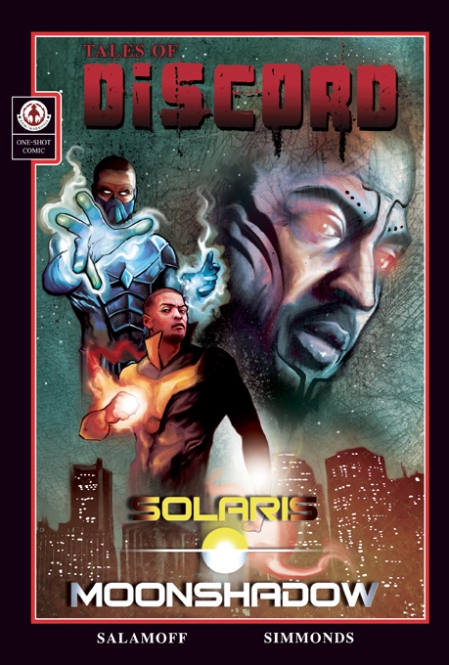The original artist for TALES OF DISCORD: SOLARIS & MOONSHADOW had to bow out because of scheduling reasons, but you know what “They” say: Things happen for a reason.
Well, just take a look at this incredible new cover and you’ll see just how right “They” were! So please meet its creator, the fourth new artist in the TALES OF DISCORD family, MARTIN SIMMONDS from the UK who will be taking the reins on SOLARIS & MOONSHADOW.
Here’s a brief Q&A I conducted with Martin so you can get to know him better:
Tell us a bit about you and how you got into comics.
I’m a professional illustrator and comic artist based in the UK and a huge fan of science fiction, horror and the super hero genre. Comics have always been a massive influence on me since childhood and without question creating comics has proved to be an extremely challenging and rewarding art form and one which I am excited to be involved in. I began submitting tryout scripts and attending portfolio reviews at comic conventions which allowed me to meet a lot of like-minded and creative people which in turn led to collaborations on various projects including TALES OF DISCORD.
What attracted you to DISCORD and helping to expand the universe?
An original concept and a fantastic script. All the characters in the Discord universe are extremely well crafted and unique which makes my job of visualizing the characters so much easier and a joy to work on.
What excites you most about your particular character?
Solaris and Moonshadow are excellent characters to illustrate. Two siblings discovering and mastering their respective superpowers and the inevitable rivalry that develops is a really interesting concept.
What are the strengths of your particular style?
I like to do fully painted sequential art where possible. Although it’s a time-consuming approach it’s ultimately a rewarding end product. More than anything, I enjoy combining realism with a more stylized, expressive approach to create something distinctive.
Who are your biggest influences?
So many to name! Bill Sienkiewicz, Kent Williams and Dave McKean had a significant impact on me when I was growing up and their artwork still amazes me to this day, also Brian Bolland, Mike McMahon, Carlos Ezquerra, Glenn Fabry and Cam Kennedy. More recent influences include Frazer Irving, Jock and Frank Quitely who create such distinct and beautiful work and in my opinion are pioneers of the medium. I also love the work of Alex Ross, Tommy Lee Edwards and Greg Tocchini.
How do you stay motivated over the amount of time it takes to draw an issue?
It’s easy to remain motivated as I get to draw each day and make a living from it so it seems like a good deal to me! It’s long hours and does take commitment but that isn’t a problem when it’s something you love doing.
Given that there is no industry standard for a comic script what info do you need from the writer in order to do your job? Do you tend to like the writer to be extremely specific or do you like vague descriptions so you can bring your vision to the project?
I love creating the artwork based on clear directions from the writer but it’s also great to have the opportunity to interpret the script and expand on any visual descriptions in order to put your own stamp on the artwork. Comics are a collaborative art form and that’s what makes it interesting as the look and feel will develop and evolve as the writer and artist swap ideas. It’s paramount for the artist to communicate the story as clearly as possible from panel to panel, for example, it may be that there is a more effective panel configuration than that laid out by the writer and the artist would make suggestions to improve on it. However specific the script is, there should always be room to make changes.
Do you have any advice for aspiring artists?
Draw as much as you can. Get used to drawing everything from human anatomy (not just muscle-bound beefcakes!) to animals to buildings, anything that will help create convincing imagery. Aside from being able to draw everything and anything, it’s essential that you are able to tell the story as clearly as possible in order to enhance the storytelling. Comic conventions are a great place to meet people, get advice and see other artists’ work first hand. Portfolio reviews are an excellent way to get a direct appraisal of your work from people already working in the industry and to make important contacts. Most of all, the best way to get experience and improve is to collaborate with others and work towards deadlines even if it’s self-publishing (or online) a mini comic or fanzine.

